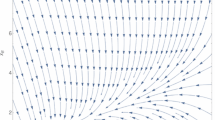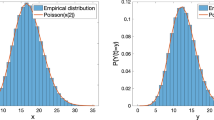Abstract
We consider the relationship between stationary distributions for stochastic models of reaction systems and Lyapunov functions for their deterministic counterparts. Specifically, we derive the well-known Lyapunov function of reaction network theory as a scaling limit of the non-equilibrium potential of the stationary distribution of stochastically modeled complex balanced systems. We extend this result to general birth–death models and demonstrate via example that similar scaling limits can yield Lyapunov functions even for models that are not complex or detailed balanced, and may even have multiple equilibria.

Similar content being viewed by others
Notes
By equilibrium we mean a fixed point of a dynamical system. In particular, what is referred to in the biochemistry literature as a “non-equilibrium steady state” is also included in our use of the term equilibrium.
References
Allen LJS (2003) An introduction to stochastic processes with applications to biology. Pearson Education, New Jersey
Anderson DF (2008) Global asymptotic stability for a class of nonlinear chemical equations. SIAM J Appl Math 68(5):1464–1476
Anderson DF, Craciun G, Kurtz TG (2010) Product-form stationary distributions for deficiency zero chemical reaction networks. Bull Math Biol 72(8):1947–1970
Anderson DF, Shiu A (2010) The dynamics of weakly reversible population processes near facets. SIAM J Appl Math 70(6):1840–1858
Anderson DF (2011) A proof of the global attractor conjecture in the single linkage class case. SIAM J Appl Math 71(4):1487–1508
Anderson DF, Kurtz TG (2011) Continuous time Markov chain models for chemical reaction networks. In: Koeppl H et al (eds) Design and analysis of biomolecular circuits: engineering approaches to systems and synthetic biology. Springer, Berlin, pp 3–42
Anderson DF, Enciso GA, Johnston MD (2014) Stochastic analysis of biochemical reaction networks with absolute concentration robustness. J R Soc Interface 11(93):20130943
Anderson DF, Kurtz TG (2015) Stochastic analysis of biochemical systems. Springer, Berlin
Chan C, Liu X, Wang L, Bardwell L, Nie Q, Enciso G (2012) Protein scaffolds can enhance the bistability of multisite phosphorylation systems. PLoS Comput Biol 8(6):e1002551
Craciun G, Dickenstein A, Shiu A, Sturmfels B (2009) Toric dynamical systems. J Symb Comput 44:1551–1565
Craciun G, Nazarov F, Pantea C (2013) Persistence and permanence of mass-action and power-law dynamical systems. SIAM J Appl Math 73(1):305–329
Duncan TM, Reed MC, Frederik Nijhout H (2013) A population model of folate-mediated one-carbon metabolism. Nutrients 5(7):2457–2474
Elowitz MB, Levin AJ, Siggia ED, Swain PS (2002) Stochastic gene expression in a single cell. Science 297(5584):1183–1186
Engblom S (2009) Spectral approximation of solutions to the chemical master equation. J Comput Appl Math 229:208–221
Ethier SN, Kurtz TG (1986) Markov processes: characterization and convergence. Wiley, New York
Feinberg M (1979) Lectures on chemical reaction networks. Delivered at the Mathematics Research Center, Univ. Wisc.-Madison. http://crnt.engineering.osu.edu/LecturesOnReactionNetworks
Feinberg M (1995) Existence and uniqueness of steady states for a class of chemical reaction networks. Arch Rational Mech Anal 132:311–370
Gadgil C, Lee CH, Othmer HG (2005) A stochastic analysis of first-order reaction networks. Bull Math Biol 67:901–946
Gardiner CW (1985) Handbook of stochastic methods, 2nd edn. Spinger, Berlin
Gnacadja G (2009) Univalent positive polynomial maps and the equilibrium state of chemical networks of reversible binding reactions. Adv Appl Math 43(4):394–414
Gopalkrishnan M, Miller E, Shiu A (2014) A geometric approach to the global attractor conjecture. SIAM J Appl Dyn Syst 13(2):758–797
Gradshteyn IS, Ryzhik IM (2007) Tables of integrals, series, and products, 7th edn. Academic Press, London
Gunawardena J (2003) Chemical reaction network theory for in-silico biologists. http://vcp.med.harvard.edu/papers/crnt.pdf
Gunawardena J (2005) Multisite protein phosphorylation makes a good threshold but can be a poor switch. PNAS 102(41):14617–14622
Gupta A, Khammash M (2013) Determining the long-term behavior of cell populations: a new procedure for detecting ergodicity in large stochastic reaction networks. arXiv:1312.2879
Heuett WJ, Qian H (2006) Grand canonical Markov model: a stochastic theory for open nonequilibrium biochemical networks. J Chem Phys 124:044110
Horn FJM (1972) Necessary and sufficient conditions for complex balancing in chemical kinetics. Arch Rat Mech Anal 49(3):172–186
Horn FJM, Jackson R (1972) General mass action kinetics. Arch Rat Mech Anal 47:81–116
Kang H-W, Zheng L, Othmer HG (2012) A new method for choosing the computational cell in stochastic reaction–diffusion systems. J Math Biol 65(6–7):1017–1099
Karlin S, Taylor HM (1975) A first course in stochastic processes, 2nd edn. Academic Press, London
Kurtz TG (1972) The relationship between stochastic and deterministic models for chemical reactions. J Chem Phys 57(7):2976–2978
Kurtz TG (1977/78) Strong approximation theorems for density dependent Markov chains. Stoch Proc Appl 6:223–240
Kurtz TG (1980) Representations of markov processes as multiparameter time changes. Ann. Probab. 8(4):682–715
Kurtz TG (1981) Approximation of population processes. In: CBMS-NSF regular conference series in applied mathematics, vol. 36. SIAM
May RMC (2001) Stability and complexity in model ecosystems, vol 6. Princeton University Press, Princeton
Pantea C (2012) On the persistence and global stability of mass-action systems. SIAM J Math Anal 44(3):1636–1673
Paulevé L, Craciun G, Koeppl H (2014) Dynamical properties of discrete reaction networks. J Math Biol 69(1):55–72
Perko L (2000) Differential equations and dynamical systems, 3rd edn. Springer, Berlin
Qian H (2011) Nonlinear stochastic dynamics of mesoscopic homogeneous biochemical reaction systems—an analytical theory. Nonlinearity 24:R19–R49
Shinar G, Feinberg M (2010) Structural sources of robustness in biochemical reaction networks. Science 327(5971):1389–1391
Smith HL, Thieme HR (2011) Dynamical systems and population persistence, vol 118. American Mathematical Soc., Providence
Sontag ED (2001) Structure and stability of certain chemical networks and applications to the kinetic proofreading of t-cell receptor signal transduction. IEEE Trans Autom Control 46(7):1028–1047
Tyson JJ, Chen KC, Novak B (2003) Sniffers, buzzers, toggles and blinkers: dynamics of regulatory and signaling pathways in the cell. Curr Opin Cell Biol 15(2):221–231
Whittle P (1986) Systems in stochastic equilibrium. Wiley, New York
Wilkinson DJ (2006) Stochastic modelling for systems biology. Chapman and Hall/CRC Press, Boca Raton
Acknowledgments
We thank the American Institute of Mathematics for hosting a workshop at which this research was initiated. Anderson was supported by NSF Grants DMS-1009275 and DMS-1318832 and Army Research Office Grant W911NF-14-1-0401. Craciun was supported by NSF Grant DMS1412643 and NIH Grant R01GM086881. Wiuf was supported by the Lundbeck Foundation (Denmark), the Carlsberg Foundation (Denmark), Collstrups Fond (Denmark), and the Danish Research Council. Part of this work was carried out while Wiuf visited the Isaac Newton Institute in 2014.
Author information
Authors and Affiliations
Corresponding author
Electronic supplementary material
Below is the link to the electronic supplementary material.
Rights and permissions
About this article
Cite this article
Anderson, D.F., Craciun, G., Gopalkrishnan, M. et al. Lyapunov Functions, Stationary Distributions, and Non-equilibrium Potential for Reaction Networks. Bull Math Biol 77, 1744–1767 (2015). https://doi.org/10.1007/s11538-015-0102-8
Received:
Accepted:
Published:
Issue Date:
DOI: https://doi.org/10.1007/s11538-015-0102-8




